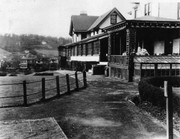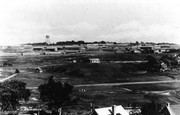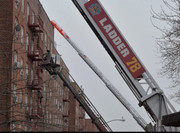Park Hill neighborhood - used to get a lot of runs into this SI neighborhood
History (Wikipedia) Clifton - Park Hill SI:
"In 1900 the Fox Hills Golf Club encompassed the entire area of where the Park Hill Apartments are now. There was a big clubhouse on Vanderbilt Avenue. Many tournaments were held there until the 1920s when it closed. The land was taken over by the government and used for military barracks during World War II. By the 1950s, it evolved into a middle-class, multi-ethnic community of civil employees including firemen, teachers, and doctors.
The Park Hill Apartments, located on Vanderbilt Avenue and on Park Hill Avenue, were initially developed in the 1960s as a private apartment complex to which many people from the other boroughs of NYC moved after the opening of the Verrazano-Narrows Bridge. By the late 1960s, however, people realized that it was relatively inexpensive to move to Staten Island and purchase a home or rent an apartment in smaller buildings, which resulted in a loss of the emerging middle-class population it initially attracted. Park Hill remained privately owned but became federally subsidized low-income housing complex, and became the site of steadily increasing crime and drug abuse beginning in the early-1970s.
By the late 1980s it had gained the nickname of "Crack Hill" due to the many arrests for possession and/or sale of crack cocaine that were taking place in and around the development and the adjacent Fox Hills Apartments to the south. Crime in this area has dramatically decreased since the late 1990s. Community activists are addressing the ongoing conflict between Liberian and African-American youth, primarily between the ages of 10?14. The community organizations run after-school programs to help keep the youth occupied in a productive way. This helps curb gang and street violence. The community tension that occurs in Park Hill is based on poverty and unemployment.
In the 1990s, the neighborhood became the center for an immigrant community from Liberia and West Africa around Targee Street. The residences in the neighborhood are mostly one-family houses, but the last decade has seen the development of many attached homes and duplexes."
Fox Hills Golf Club - Vanderbuilt Ave - 1900-1920:

Military Hospital - US Army - WWI and then WWII:

History and Development:
In 1918 during the first World War, Hoff General Hospital No. 41 was built on land adjacent to the Fox Hills Golf Course. Constructed in a record four months at a cost of $2 million, the facility was the largest army hospital in the world with a capacity for 3,000 patients.
The Fox Hills Base Hospital, as it became known, operated until 1922, when it was determined that the rundown hospital had become a firetrap. The facility closed on March 7, 1922, and the few remaining patients were transferred to Sea View Hospital.
The Fox Hills Base Hospital, as it became known, featured three miles of interconnected covered wooden walkways with amenities like a barber shop, billiards room, general store, and 2,000-seat theater. It operated until 1922, when the last remaining patients were transferred to Sea View Hospital.
With the arrival of the Great Depression, the Fox Hills Golf Club was no longer sustainable. The club closed its doors in 1935. By that time, the goats were long gone. (Albeit, Staten Island was New York?s last stand for goats: In 1928, The New York Times reported that 130 Staten Island residents were still licensed to keep goats.)
During World War II, the U.S. Army reactivated the old Fox Hills property to serve as an army base, an Italian prisoners of war camp, and a trading post along Vanderbilt Avenue. When the war ended, the barracks became makeshift homes for veterans who faced a severe housing shortage in the late 1940s and early 1950s. The facility shut down completely in the early 1950s.
http://hatchingcatnyc.com/2015/04/08/1900-the-goats-that-goaded-the-fox-hill-golfers-on-staten-island/
Fox Hills Terminal - Military Fire Department- WWII:
Fox Hills had 91 buildings - a US Army hospital, a training site for stevedores (loaded/unloaded cargo), a POW camp for prisoners who requested American citizenship and barracks for troops waiting to be shipped overseas. Military complex had base military fire department and a 2-bay firehouse with 3 pumpers. The barracks and housing were used for veterans returning after WWII and the base was closed and demolished in the 1950s.
Park Hill Football History:
Stapleton/Park Hill is the former home of the National Football League in Staten Island - 1929-1932.
The Staten Island Stapletons were a semipro team founded by restaurateur Dan Blaine in 1915, who played halfback for the team until 1924. Over the following couple of seasons, the Stapes would play exhibitions against pro teams from the NFL and the 1920s version of the American Football League, and after they rolled up a 10-1-1 record in 1928 the Stapes joined the NFL the next season, playing in tiny Thompson?s Stadium on Tompkins Avenue, a site now occupied by Stapleton Housing (located between Broad, Hill and warren Streets and Tompkins Avenue, itself named for a 19th-Century area resident, Daniel D. Tompkins, Vice President under James Monroe from 1817-1825.
Led by halfback Ken Strong, a New York University graduate, the Stapletons compiled a 14-22-9 record against NFL competition in four years. The Stapes played an exhibition schedule in 1933, with some games against NFL teams, before Blaine folded the team and Strong joined the New York Giants.
http://sportsecyclopedia.com/nfl/statenisland/stapletons.html
https://en.wikipedia.org/wiki/Staten_Island_Stapletons
http://forgotten-ny.com/2007/08/adventures-in-vandyland-park-hill-staten-island/







